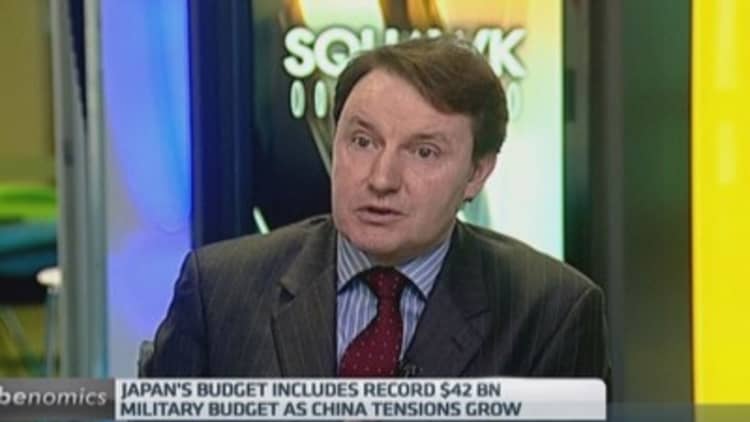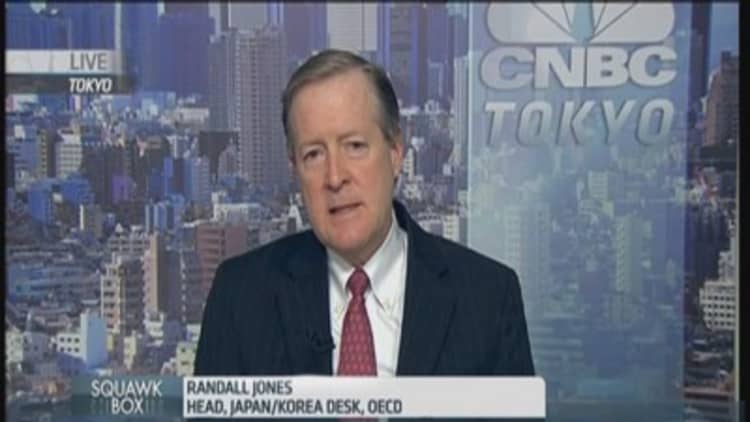The Bank of Japan is in a bind: cheaper oil prices are almost certain to slow inflation and force the central bank to miss its 2 percent target set for this year. But economists are divided over whether the BOJ will act.
The central bank fired its last bazooka back in October, when it expanded its quantitative easing program, swelling Japan's monetary base by around 80 trillion yen ($682.9bn) per annum. While the BOJ is unlikely to announce anything new when it wraps up its two-day meeting on Wednesday, it is expected to cut its CPI (consumer price index) forecasts to 1.5 percent, according to local media reports.
Shinichiro Kobyashi, Mitsubishi UFJ Research and Consulting's (MURC) senior economist, believes "the BOJ will stick to its guns for now," but launch one more round of quantitative easing in April.
"The whole point of its policy is an unwavering commitment to beating deflation so they will just keep on claiming they can meet their targets – just at a later date," Kobyashi said.

He is forecasting core inflation will only rise at 0.3 percent in the fiscal year 2015 to the end of March 2016, assuming oil prices have now pretty much bottomed out. Last November, core inflation slowed to 0.7 percent, according to government data, from 0.9 percent the previous month.
"The BOJ "faces a high-wire act in 2015," said HSBC economist Izumi Devalier. " Despite having delivered another round of fireworks less than three months ago, disinflationary pressures have risen further," she noted, citing the plunging oil prices.
Read MoreBOJ puts Japan bond yields on road to nowhere
"Oil prices are still falling, and there is a good chance that core inflation will turn negative in the first three months of 2015, dragging down inflation expectations with it," Devalier added.
Not everyone agrees the BOJ is itching to pull the trigger, however.
"At this stage, we expect the BOJ to refrain from further quantitative easing," said Khohei Morita, Barclays' economist in a note.
While falling oil prices will force the BOJ to "cut its CPI forecasts for the fiscal years 2014 and 2015," the BOJ will argue that "inflation expectations will remain anchored and retain its projection for FY16", he said.
"We see the chances as minimal since the bank just eased last October," said Mikihiro Matsuoka,Deutsche Bank's chief economist. But he too thinks "one possible policy change would be a shift in the price stability target to a long-term objective."

Analysts note that further action will be devastating for yields on Japanese government bonds: yields on maturities shorter than three years are currently in the negative while longer-term bonds are also on a steady slide.
Holding off from further quantitative easing "would be a sensible move given the harmful effects (caused by the measures taken to) reach the hoped-for 2 percent inflation rate," said DB's Matsuoka.
But "a negative aspect of such a decision would be a loss of credibility", he added.
But what can the BOJ buy next?
And with the collapse of yields, even those who believe the BOJ is determined to demonstrate its commitment to inflation aren't sure what the central bank can buy.
HSBC's Devalier reckons the BOJ will spend half of its 10 trillion yen on risk asset purchases. "Most of this will likely be Exchange Traded Funds (ETF) but the central bank also look into boosting its existing purchases of commercial paper, corporate bonds and shares in Japanese real investment trusts (J-REIT)," she said.
In theory, "the BOJ can buy what it wants, at the price it wants – even at negative yields," said MURC's Kobayashi, but notes that the real paradox is that inflation is no longer critical to Japan's economy.
"Growth can be achieved without price inflation – all we need is modest but stable wage growth of 0.4 percent on-year and stable prices, which in turn will encourage a rise in private consumption," he said.

